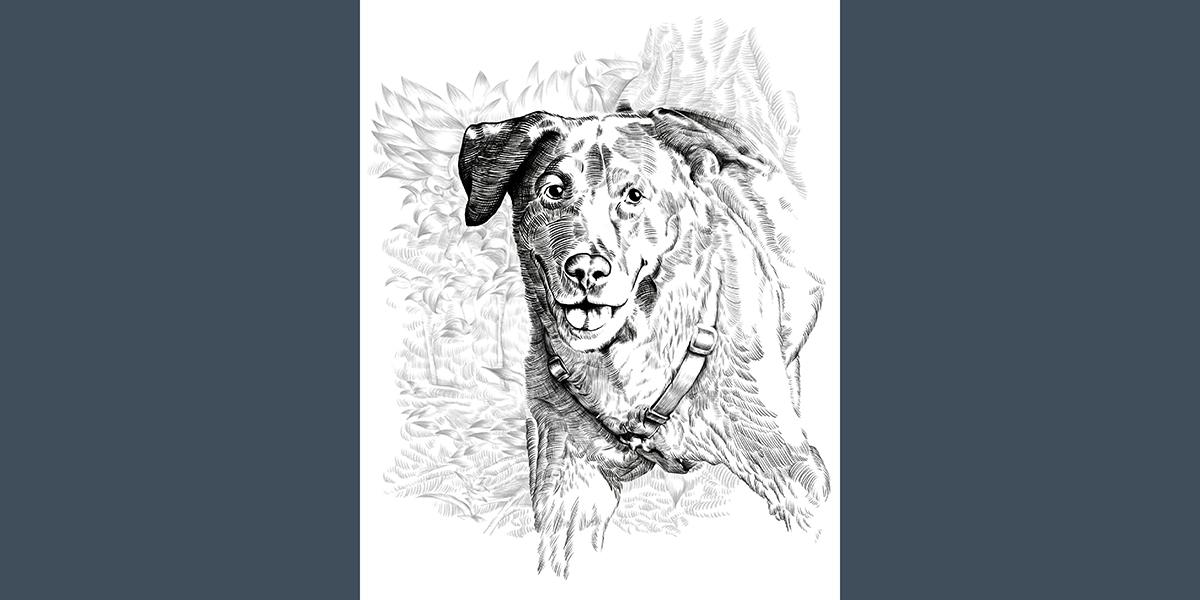Evangelists for acupuncture
Anne and Litton Field turn to the VMC and an ancient healing therapy to care for their animals.

Anne and Litton Field turn to the VMC and an ancient healing therapy to care for their animals.
Illustration by Hairun Li
Dog and horse enthusiasts Anne and Litton Field have long relied on veterinarians when their animals need care. But 2001 was a pivotal year. Their 10-year-old chocolate Labrador, OD, was in considerable pain, and their veterinarian, Mark Goodell, had reached the limit of what Western medicine could do. Then he suggested something unexpected.
Goodell directed the couple to the University of Minnesota Veterinary Medical Center (VMC)—specifically to Keum Hwa Choi, DVM, MS, ’90 PhD, CVA, MSOMD, LAc, Diplomate NCCAOM, an associate professor in the College’s Department of Clinical Sciences. She founded the Complementary and Alternative Medicine Service at the VMC.
Choi believes an integrative approach that combines Eastern and Western treatments is the future of veterinary medicine. It’s a philosophy that underscores her work at the VMC, where she sees animals of all sizes as well as raptors. The treatments she provides include acupuncture, acupressure and massage, oriental medicine, food therapy, and herbal medicine.
Like acupuncture for humans, veterinary acupuncture involves inserting superfine needles into specific locations on an animal’s body to stimulate energy and a healing response. It’s a less invasive form of treatment than many Western approaches and causes fewer side effects than pain medication.
I was skeptical at first. But after several acupuncture treatments, OD felt better. Dr. Choi made a big difference.
Litton Field
“With all due respect, I was skeptical at first,” says Litton, an insurance sales executive. “But after several acupuncture treatments, OD felt better. Dr. Choi made a big difference.”
A few years later, OD developed frozen elbows from arthritis, and his pain medication for the arthritis caused an ulcer. Choi helped him recover using herbal medicine and acupuncture.
“OD was happy and calm,” says Anne, ’82 BA, a former human resources consultant. “In fact, he became a demo dog for Dr. Choi’s class in acupuncture.”
OD died in 2006 at age 15. But it was just the beginning of the relationship between Choi and the Fields. When several of their other dogs had serious health conditions, including gastrointestinal cancer, Choi did acupuncture in tandem with Western medicine treatments.
“Not only did the dogs live long lives, they were happy,” Litton says. “They went for walks, ate, and enjoyed themselves. They weren’t just lying around.”
The Fields also have a deep appreciation for the other VMC services they’ve used, including emergency medicine, oncology, surgery, orthopedic services, and the Leatherdale Equine Center.
The U is a great resource and fills a necessary gap in animal care. For example, the Equine Center has equipment no one else has, including a standing MRI.
Anne Field
“The U is a great resource and fills a necessary gap in animal care,” Anne says. “For example, the Equine Center has equipment no one else has, including a standing MRI.”
All of this prompted the Fields, who are longtime supporters of the Gopher Athletic Program, to give to the VMC—Choi’s work in specific. They made their first gift in 2002 and continue to contribute annually.
“When it comes to philanthropy, we focus on causes that are meaningful to us. And it’s always the people who make the difference,” Litton says.
Anne agrees. “It’s easy to feel like a number at the U because it’s so big, but we never feel that way at the VMC,” she says. “In every experience we’ve had there, we’ve been offered options, all of which have been realistic. And the level of care is remarkable. After one emergency visit to the VMC, the doctor wrote a note thanking us for letting them provide end-of-life care for our dog.”
The Fields currently have two Labradors and a German Wirehaired Pointer. And if any of them ever needs specialized care, the couple makes a beeline for the U.
“The VMC and Dr. Choi are the Mayo Clinic of veterinary care,” says Litton.